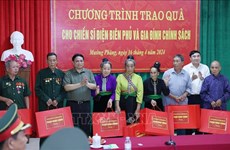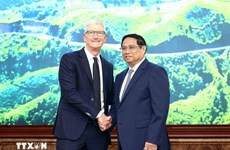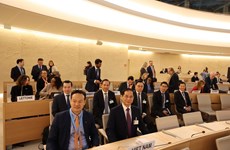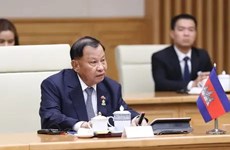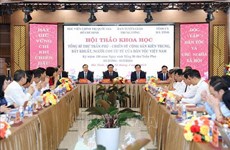Vietnam actively proffers ideas for AEC formation during AEM 47
Vietnam, together with other ASEAN member countries, contributed to finalising measures towards the formation of an ASEAN Community by year’s end during the freshly-ended AEM 47 in Kuala Lumpur.
 Deputy Minister of Industry and Trade Nguyen Cam Tu (Middle) and the Vietnamese delegation at the 47th ASEAN Economic Ministers’ Meeting. Photo: VNA
Deputy Minister of Industry and Trade Nguyen Cam Tu (Middle) and the Vietnamese delegation at the 47th ASEAN Economic Ministers’ Meeting. Photo: VNAVietnam also proffered ideas to the roadmap for developing the ASEAN Economic Community (AEC) through 2025, focusing on promoting and creating favourable conditions for trade activities.
At the same time, Vietnam also continued fostering initiatives in regional cooperation between Cambodia, Laos, Myanmar and Vietnam, as well as between Mekong Sub-regional countries and Japan for stronger economic connectivity.
This will also create sub-regional economic zones essential for the socio-economic growth of Vietnam’s central and southern localities.
Along with official activities, Deputy Minister of Industry and Trade Nguyen Cam Tu, who led the Vietnamese delegation, also met with a number of economic ministers within ASEAN as well as from Vietnam’s partner countries including Japan, Cambodia, Laos and Myanmar to bolster bilateral economic and trade relations.
ASEAN has become one of the top partners of Vietnam, who has been a member of the association for 20 years and accounts for 14 percent of the country’s total trade revenue.
Last year, trade reached 42.12 billion USD with Vietnam’s exports accounting for 19 billion USD, equivalent to 12.7 percent of the country’s total figure.
Vietnam mainly exported crude oil, steel, equipment and spare part, rice, apparel and seafood to ASEAN countries while importing nearly 23 billion USD worth of goods or 15.5 percent of the country’s total imports.
By the end of June, ASEAN investors had 2,632 FDI projects valued at 54.6 billion USD in Vietnam, focusing on processing, manufacturing, real estate and construction. ASEAN is also a traditional investment destination of Vietnam.
During the AEM 47 and related meetings which took place from August 22-25, the ASEAN economic ministers reaffirmed their determination to establish the AEC at the end of this year despite challenges from regional and global economic impacts.
By the end of July this year, over 91 percent of the formation targets had been completed. Vietnam has been one of the leading countries in realising prioritised measures with 94.5 percent completed.
The ministers expressed ASEAN’s continued commitment towards efforts to enhance trade facilitation through initiatives like Self-Certification, ASEAN Trade Repository, ASEAN Solutions for Investments, Services and Trade (ASSIST), ASEAN Single Window, Standards and Conformance.
They welcomed the progress on the implementation of the ASEAN Comprehensive Investment Agreement (ACIA), which serves as ASEAN’s main economic instrument in realising the free flow of investment.
On external relations, the ministers reaffirmed the importance of building an open ASEAN that is integrated into the global economy. They welcomed the signing and implementation of ASEAN-India Trade in Services and Investment Agreements as well as on-going efforts to enhance existing FTAs with dialogue partners.
These include upgrades to the ASEAN-China FTA Agreement; finalisation of the Third Protocol to Amend the ASEAN-Korea Trade in Goods Agreement; the modality for further liberalisation of products under the ASEAN-Korea FTA; arrangements for the implementation of the Protocol to Amend the Agreement on establishing the AANZFTA; and the adoption of the scope of the review of ASEAN-India Trade in Goods Agreement.
The ministers welcomed the continuing close cooperation with dialogue partners through the adoption of new trade and investment cooperation work programmes. They also welcomed the support and assistance of dialogue partners in ASEAN’s internal integration programmes.
The ministers welcomed the progress made in the RCEP negotiations to date, and commended efforts made by all RCEP Participating Countries in moving towards market access negotiations.
The minister also endorsed the AEC Blueprint 2025 in principle, a document that charts the agenda for ASEAN economic integration from 2016 to 2025.
By 2025, the AEC is envisioned to be highly integrated, cohesive, competitive, innovative and dynamic with enhanced economic connectivity as well as integration and cooperation across sectors while fostering a more resilient, inclusive, and people-oriented, people-centred community that is integrated into the global economy.-VNA






